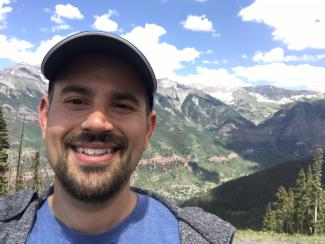Event
Physical Chemistry Seminar: Dr. David Masiello
"Nanometer-Scale Spatial and Spectral Mapping of Exciton Polaritons in Structured Plasmonic Cavities"

Abstract
Exciton polaritons (EPs) are ubiquitous light-matter excitations under intense investigation as test beds of fundamental physics and as components for all-optical computing. Owing to their unique attributes and facile experimental tunability, EPs potentially enable strong nonlinearities, condensation, and superfluidity at room temperature. However, the diffraction limit of light and broad momentum content of fast electron probes preclude the characterization of EPs in nanoscale structured cavities exhibiting energy-momentum dispersion. Through an innovative combination of electron beam and optical probes, I will show theoretically that these limitations can be overcome to measure EPs in periodic nanophotonic cavities at their natural energy, momentum, and length scales via lattice electron energy gain spectroscopy. With the combined high momentum resolution of light and nanoscale spatial resolution of free-space focused electron beams, lattice electron energy gain spectroscopy can expose deeply subwavelength EP features using currently available monochromated, aberration-corrected scanning transmission electron microscopes (STEMs).Time permitting, I will also discuss the addition of polarization structure to the STEM electron probe and demonstrate theoretically how this degree of freedom can be harnessed to characterize the 3D polarization-resolved response field and local chirality of an optically excited target with nanoscale spatial resolution.
Research
FAST ELECTRON NANO-SPECTROSCOPY
Pushing the boundaries of fast electron spectroscopy, energy-monochromated and aberration-corrected scanning transmission electron microscopes have opened the far infrared to nanometer scale spatial mapping. Together with experiment, we leverage these advances to resolve open fundamental questions in nano-spectroscopy, perform entirely new materials characterization techniques at the single-particle level, and discover advanced materials endowed with unprecedented functionalities.
NANOPHOTONICS / QUANTUM OPTICS
Coupling between light and matter is extraordinarily weak. Optical resonator cavities provide an opportunity to coax repeated light-matter interactions, thereby enhancing coupling far beyond that of free space. In such settings, coupling can be so strong that it is no longer possible to disentangle the original optical and material degrees of freedom, resulting in non-equilibrium quantum optical states endowed with properties beyond those of their components.
PHOTOTHERMAL SPECTROSCOPY AND MICROSCOPY
Measurement of the two distinct components—scattering and absorption—of a single particle’s optical extinction provides fundamentally important and complementary information on how that object processes light: either scattering it back to the far-field or converting it into internal excitation.
https://faculty.washington.edu/masiello/
HOST: Profs Fakhraai & Subotnik
